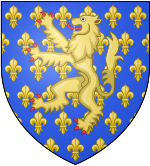
Back Henry de Beaumont, 1. Baron Beaumont German Ερρίκος του Μπωμόν Greek Enrique de Beaumont Spanish Henri de Beaumont (1er baron Beaumont) French Enrico di Beaumont Italian Генри де Бомонт, 1-й барон Бомонт Russian
This article includes a list of general references, but it lacks sufficient corresponding inline citations. (March 2019) |
Henry de Beaumont | |
|---|---|
| 4th Earl of Buchan & 1st Baron Beaumont | |
 | |
| Born | bef. 1280 France |
| Died | 10 March 1340 |
| Noble family | de Brienne |
| Spouse(s) | Alice Comyn, Countess of Buchan |
| Father | Louis de Brienne |
| Mother | Agnès de Beaumont |
Henry de Beaumont (before 1280 – 10 March 1340), jure uxoris 4th Earl of Buchan and suo jure 1st Baron Beaumont, was a key figure in the Anglo-Scots wars of the thirteenth and fourteenth centuries, known as the Wars of Scottish Independence.
Henry de Beaumont was a veteran campaigner who participated in every major engagement, from the Battle of Falkirk in 1298 to the Battle of Halidon Hill in 1333. Although not now a widely known figure, he was, nevertheless, of considerable military and political importance. His long experience in the Scottish wars led him to develop a battle technique later used to great effect at Crécy and Agincourt.
As one of a group of Anglo-Scots nobles later known as the 'disinherited'—Englishmen whose Scottish lands had been forfeited—he was to do much to overturn the peace between England and Scotland established by the Treaty of Northampton and bring about a Second War of Scottish Independence.
By his marriage, shortly before 14 July 1310, to Alice Comyn, Countess of Buchan (died 3 July 1349), the niece and heir of John Comyn, Earl of Buchan, he was recognised as earl in right of his wife.
- ^ Debrett's Peerage, 1968, Beaumont baronets, p. 59
© MMXXIII Rich X Search. We shall prevail. All rights reserved. Rich X Search